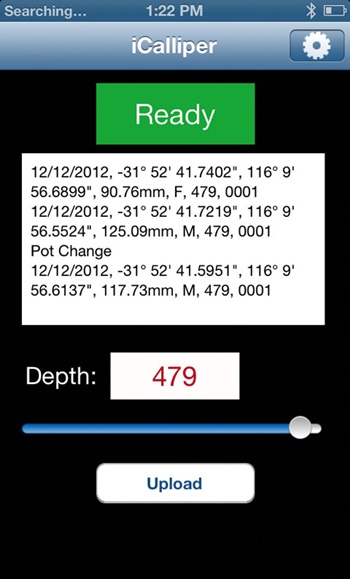A new smartphone app that allows commercial crab fishers to collect detailed, near-real-time catch data is proving a cost-effective alternative to traditional monitoring
By Natasha Prokop

Take a pair of vernier callipers, add wireless bluetooth capacity and link it to a smartphone data-recording app and what emerges is a new tool that is revolutionising monitoring for Western Australia’s Crystal Crab fishery.
It allows for the ongoing gathering of information as fishers fish across the entire fishery, which spans more than 1000 kilometres of coastline from Fremantle north to Carnarvon. It is a tool that has the potential to be adapted for the monitoring of a wide range of other crustaceans, according to scientists at the WA Department of Fisheries, who have been leading the project.
Crystal Crabs (Chaceon albus) are endemic to WA, and are part of the West Coast Deep Sea Crustacean Managed Fishery. The species is slow-growing, lives for up to 30 years and is highly sought after by seafood connoisseurs.
They are considered one of the best-tasting crab species; the tender, white flesh has a subtle, sweet taste, thought to be a result of the deep, cold and clean water in which they live.
But collecting high-quality catch data to assist with stock assessments, while keeping monitoring costs down, has been a major challenge for the fishery.
Catch length and frequency data are essential for stock assessments and setting catch quota. In the past this has been collected by research technicians from the WA Department of Fisheries.
However, the size and sex ratios of this species vary with depth and location, so data collected a few times a year by technicians was not seen as representative of the entire fishery.
Given the distances involved, and that there are relatively few boats in the fishery, these monitoring trips are also prohibitively expensive.
Seeking to overcome these challenges, Curtin University researcher Roy Melville-Smith has led an FRDC-funded project to develop a more comprehensive and cost-effective monitoring system.
“We wanted to set up something where the fishers could record data by sampling the pots each day, giving us a good spread of data across the whole area they were fishing, rather than the snapshot when a technician is onboard,” he says.
Innovative
 Modified vernier callipers used in the iCalliper sampling system. Photo: B Hebton, Department of Fisheries, WA
Modified vernier callipers used in the iCalliper sampling system. Photo: B Hebton, Department of Fisheries, WA The system that emerged from the project is called the iCalliper sampling system. It has adapted the widely used vernier callipers, fitting them with a bluetooth function that links with a smartphone via a specially designed app.
This app enables the size and sex of the crabs to be combined with the date, time and location-recording capabilities of smartphones.
The result is a system capable of capturing and transmitting high-quality data to scientists several hundred kilometres away in Perth, whenever fishers return to land.
Developing this technology was not without its challenges, Roy Melville-Smith says. Modifications to the calipers were made based on fisher feedback to make the system as user-friendly as possible, and to ensure fishers could collect data efficiently without hindering their own operations.
This included changing touch-screen switches that were too sensitive for rough sea conditions and relocating buttons on the equipment so that those used most frequently by the fishers were within closest reach.
The WA Department of Fisheries oversees the crustacean fishery monitoring program and researcher Jason How says the usability of technology is crucial when the department seeks assistance from fishers with monitoring activities.
“We often rely on the fishing industry to give us information and whatever we can do to make it easier to collect, the more likely we are to get that data,” he says. “The better the data we have, the better management decisions we can make.”
Further developments
The data the department has received in the year since the iCalliper system was introduced has been both good quality and useful in monitoring efforts. Jason How says there are now plans to modify the system to further enhance its usefulness.
The changes would allow fishers to record additional inputs for undersized crabs captured in modified research mesh pots. “With this information we can get a better understanding of the numbers of animals moving into the fishery and then we will have more certainty about how the fishery is performing,” Jason How says.
This recruitment data will be particularly useful for the Crystal Crab fishery in WA as it prepares to undergo Marine Stewardship Council certification.
Jason How says the ability of the iCalliper system to gather information more efficiently and to reduce the cost of monitoring means it also has great potential in other fisheries. “It’s a great system that has been developed and, with a few minor modifications, it can be used in a suite of monitoring activities for all crustacean fisheries in the state.”
FRDC Research Codes: 2001-055, 2011-254
More information
Jason How, 08 9203 0247, jason.how@fish.wa.gov.au





